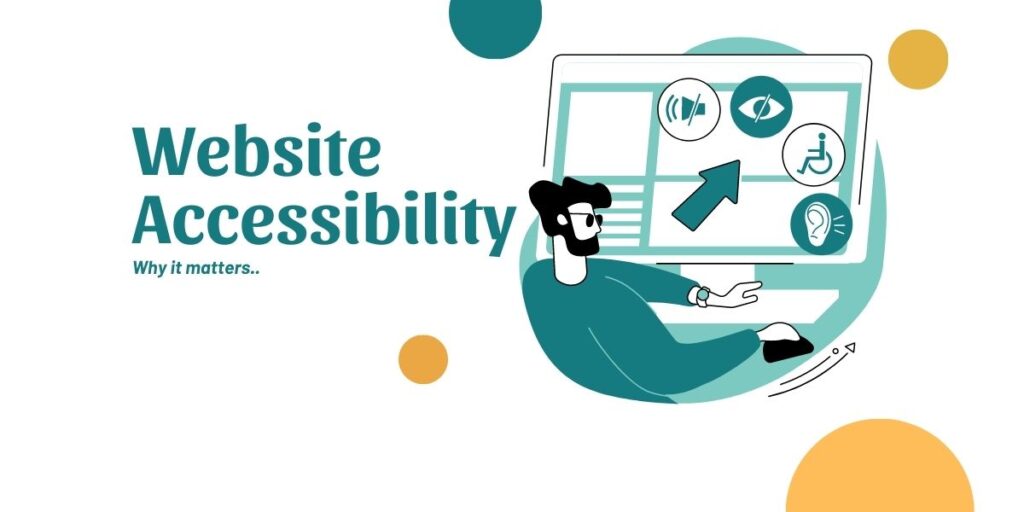As we’re all turning to the web more and more for everything from shopping and banking to learning and socializing, it’s becoming absolutely vital that these online platforms are open to all, no matter what physical, cognitive, or sensory challenges one might be facing.
This blog post sheds light on the importance of website accessibility, its pivotal role in inclusive design, and how it can positively impact businesses.
What’s the Deal with Website Accessibility?
Website accessibility is all about forging a website that anyone and everyone—including those living with disabilities—can utilize without facing any hindrance. It’s about tailoring a website equipped with features in sync with various assistive tools—like screen readers for individuals with sight impairments or voice recognition software for those who struggle with using a mouse or keyboard.
The importance of website accessibility cannot be overstated. It’s about equality and inclusivity and creating an optimal digital experience for all users. When websites are accessible, they cater to a broader range of people, including those with visual, hearing, motor, or cognitive impairments. Furthermore, website accessibility extends beyond disabilities; it benefits older adults experiencing changes in vision or dexterity, people with temporary injuries, or even those using a small mobile screen in bright sunlight. It touches every aspect of society, making it a crucial component of websites.
The Role of Website Accessibility in Inclusive Design
Inclusive design is a methodology that involves developing products and services with the diverse needs and experiences of a broad range of users in mind. It’s about understanding that each user will interact with your website differently and ensuring it is designed to cater to these variances.
Website accessibility is an integral part of this design philosophy. By considering accessibility from the beginning stages of website design and development, you ensure that your website complies with legal standards and is usable and enjoyable for a wide range of users, including those with disabilities. It entails careful consideration of color contrast, text size, keyboard navigation, and compatibility with assistive technologies.
Consider, for instance, a site that incorporates alt text for images. This helps visually impaired users understand the content through a screen reader, creating a more inclusive environment. Or a website that provides transcripts for video content—this assists not only deaf or hard-of-hearing users but also those who prefer to read rather than watch or listen to content. Such inclusive design practices empower users, making the internet more accessible and usable for everyone.

Legal Implications of Website Accessibility
Over the years, website accessibility has evolved from a moral duty into a legal requirement in many regions across the globe. Several laws and regulations, such as the Americans with Disabilities Act (ADA) in the United States and the Web Content Accessibility Guidelines (WCAG) laid down by the World Wide Web Consortium (W3C), have put forth guidelines and standards to ensure digital accessibility.
The ADA, for instance, requires businesses to make accommodations for people with disabilities in all their services, including digital platforms. Similarly, the WCAG provides a detailed checklist for making web content more accessible, outlining different conformance levels.
Recent years have seen an increase in litigation related to website accessibility. Businesses that fail to comply with these accessibility standards often face legal action, resulting in hefty fines and reputational damage. For instance, the well-publicized case of Domino’s Pizza in 2019, where a visually impaired customer successfully sued the company because their website and app weren’t accessible, underscores the increasing importance of taking website accessibility seriously. Such legal precedents highlight the urgency for businesses to ensure their digital properties are accessible to all.
Benefits of Website Accessibility to Businesses
When businesses invest in website accessibility, they reap numerous benefits that often go beyond legal compliance.
Expanding the customer base: Nearly 15% of the world’s population experiences disability. By making a website accessible, businesses open their doors to this significant portion of the people, expanding their potential customer base.
Enhancing brand reputation and corporate social responsibility: An accessible website reflects a company’s commitment to inclusivity and equality. It showcases that the business values all its customers, which can significantly boost its reputation and demonstrate a commitment to corporate social responsibility.
Improving SEO performance: Many web accessibility practices overlap with SEO best practices. For example, providing alt text for images helps visually impaired users and improves search engine rankings. Similarly, well-structured content aids screen readers and search engines alike.
Reducing legal risks: As mentioned earlier, non-compliance with accessibility standards can lead to costly legal implications. By ensuring website accessibility, businesses can mitigate these legal risks.
Common Accessibility Barriers and How to Overcome Them
Despite the clear benefits and legal mandates, many websites still present accessibility barriers. Some common issues include unclear navigation, lack of keyboard functionality, low contrast between text and background, and missing alternative text for images.
Overcoming these barriers often involves a concerted effort across various aspects of website design and development:
- Straightforward Navigation: Ensure that your website structure is logical and intuitive. Use clear, concise language for menu items and links.
- Keyboard Functionality: Not all users can use a mouse. Make sure your website is fully navigable using a keyboard alone.
- Color Contrast: Ensure sufficient contrast between text and its background color to help users with visual impairments or color blindness.
- Alt Text for Images: Provide descriptive alternative text for images to assist visually impaired users who use screen readers.
To aid in these efforts, there are numerous tools and resources available that can help businesses audit their website for accessibility and provide solutions for identified issues. For instance, tools like WAVE or AXE can evaluate a website’s accessibility and highlight areas for improvement.
The Future of Website Accessibility
As we continue to evolve in a digitally-dominated era, the emphasis on website accessibility is likely to increase. Emerging web development and design trends are increasingly focused on inclusivity and user-friendliness.
For example, artificial intelligence (AI) and machine learning are critical in improving web accessibility. These advancements promise to make the web even more inclusive, from AI-based tools that auto-generate image descriptions to technologies that can predict and adapt to a user’s needs.
Additionally, as more businesses understand the value of inclusive design, there is a growing push towards ‘universal design’— a concept where websites are designed to meet the needs of the broadest range of users without needing further adaptation or specialized design.
Conclusion
Website accessibility is not just a legal obligation or a technical challenge—it’s a fundamental aspect of how we approach design and view user experiences in the digital age. An accessible website breaks down barriers, opens new markets, and offers an enhanced user experience.
In this digital age, where a vast part of our lives is spent online, ensuring everyone can participate fully and equally is essential. By making website accessibility a priority, businesses can contribute to a more inclusive and equitable internet—a place where everyone belongs and everyone can thrive.


